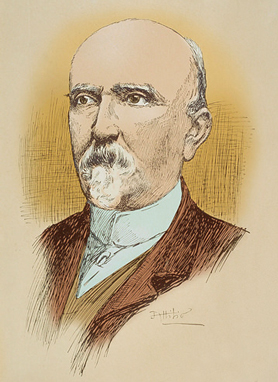C. Collodi  Pinocchio
Pinocchio
 Carlo Lorenzini, better known by his pen name, C. Collodi, was born on November 24, 1826, in Florence, capital of the Grand Duchy of Tuscany in northern Italy. Carlo, the eldest of eleven children, grew up in the medieval town of Collodi, where his mother was born. Raised mostly by his maternal grandmother, Carlo attended primary school in Collodi before being sent to study at the seminary in Colle di Val d’Elsa, near Siena. Despite the financial assistance offered to him, however, Lorenzini soon realized that he had no interest in entering the priesthood and so left the seminary to attend the College of the Scolopi Fathers in Florence.
Carlo Lorenzini, better known by his pen name, C. Collodi, was born on November 24, 1826, in Florence, capital of the Grand Duchy of Tuscany in northern Italy. Carlo, the eldest of eleven children, grew up in the medieval town of Collodi, where his mother was born. Raised mostly by his maternal grandmother, Carlo attended primary school in Collodi before being sent to study at the seminary in Colle di Val d’Elsa, near Siena. Despite the financial assistance offered to him, however, Lorenzini soon realized that he had no interest in entering the priesthood and so left the seminary to attend the College of the Scolopi Fathers in Florence.
In 1844 he took a job working for the Italian manuscript expert Giuseppe Aiazzi at the Libreria Piatti bookstore in Florence, his first step toward a literary career. He also had an active interest in politics, spurred by the fact that Italy was caught up in the Risorgimento—the political movement that advocated and ultimately achieved the unification of Italy. Lorenzini even served as a volunteer in the Tuscan army during the Italian Wars of Independence in 1848 and 1860. In between his military stints he founded two newspapers—Il Lampione, a satirical paper that was censored by the grand duke of Tuscany, and Lo Scaramuccia—where his first published writing appeared. In 1856 he published a humorous guidebook, Un Romanzo in Vapore (A Novel in Steam), and debuted a play, Gli Amici di Casa (The Friends of the House). Lorenzini’s first notable publication came in 1860, a nonfiction work outlining his social and political vision for Italy, called Il Signor Alberi Ha Ragione! (Mr. Alberi Is Right!). It also marked the first time he used the pseudonym C. Collodi.
Throughout the 1860s and 1870s, Lorenzini continued writing political pieces and satirical sketches for newspapers such as Il Fanfulla. But by the mid-1870s, after Italy’s unification, he’d become disillusioned with politics and began to turn to children’s literature, particularly fairy tales. In 1875 he published a translation of the French fairy tales of Charles Perrault, and in 1877 published three books in a children’s series centered on the unification of Italy as seen through the eponymous character of Giannettino (inspired by Alessandro Luigi Parravicini’s Giannetto), a lazy, spoiled child who learns to change his ways through the help of an old man, Doctor Boccadoro.
Lorenzini took this idea further in 1881 when he published the first installment of La Storia di un Burattino (The Story of a Marionette, as it was then called) in the July 7 issue of the children’s weekly Giornale per i Bambini. The weekly misadventures of what would become Le Avventure di Pinocchio were an instant hit, capturing the imagination of children and their parents all over Italy with the story of a marionette who wished to become a real boy. Of course, he was as mischievous, spoiled, lazy, selfish, rebellious, and dishonest as most boys, but as the story progressed, he learned to be loving, reliable, industrious, and kind—not just a real boy, but a boy other boys could emulate.
The popularity of Pinocchio, published as a book with illustrations by Enrico Mazzanti in 1883, made Lorenzini—or his pen name, Collodi—synonymous with the wooden marionette and ensured a beloved immortality for both.
Lorenzini published more stories over the next few years but died suddenly at the age of sixty-three on October 26, 1890, in Florence, where he is buried at the Cimitero Monumentale Delle Porte. Since 1962, the nonprofit Carlo Collodi National Foundation, housed in Villa Arcangeli in the town of Collodi, owns and manages Pinocchio Park.
PINOCCHIO’S LEGACY
Few fictional characters have gained a more enduring fame or more iconic status around the world than the puppet Pinocchio. That renown was no doubt cemented by the immensely popular 1940 Disney animated classic. But over the decades, adaptations in film, on television, in books, and on the stage have been too numerous to count.
The artwork Pinocchio spawned has always been an important part of the story, starting with the original anonymous illustrations that adorned the weekly installments in the pages of Giornale per i Bambini. These inspired Enrico Mazzanti’s illustrations for the first book edition in 1883, which in turn inspired Carlo Chiostri’s black-and-white drawings for the 1902 edition, both of which had an influence on Attilio Mussino’s beautiful color illustrations for the Italian edition of 1911, which were then used in the new English translation by Carol Della Chiesa for Macmillan’s 1925 American edition (and which are featured in the Top Five Classics edition).
Before Disney’s Pinocchio, there was a live-action Italian silent film (1911), and some of the more significant film adaptations that followed include: Un burattino di nome Pinocchio, an animated Italian film (1972); The Adventures of Pinocchio, starring Jonathan Taylor Thomas and Martin Landau (1996); Pinocchio (2002), with Roberto Benigni in the title role and Pinocchio (2019), with Benigni as Geppetto; Pinocchio (2022), a live-action remake of Disney’s 1940 animated musical, with Tom Hanks as Geppetto; and Pinocchio (also released in 2022), a stop-motion animated film directed by Guillermo del Toro and Mark Gustafson, with Ewan McGregor voicing the Cricket, which won an Oscar for best animated feature at the 2023 Academy Awards.
